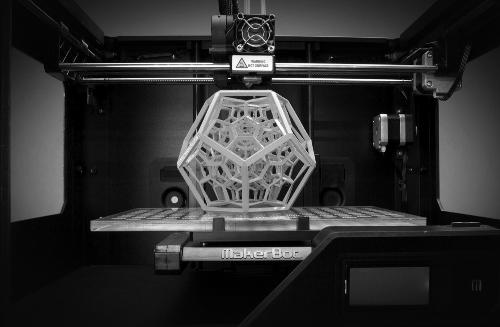When the military and the government begin looking into a unique technology — and using it for previously unheard-of exercises and means to an end — you know it’s something of significance.  But right now, the roles are reversed as the UK has been examining what we everyday people are doing with the extraordinary power of a new and almost completely unregulated technology. The UK is looking into 3D printing — this much talked about technology created by the Americans that is spreading to every corner of the globe — and they are taking out a magnifying glass for a qualitative and quantitative gander.
But right now, the roles are reversed as the UK has been examining what we everyday people are doing with the extraordinary power of a new and almost completely unregulated technology. The UK is looking into 3D printing — this much talked about technology created by the Americans that is spreading to every corner of the globe — and they are taking out a magnifying glass for a qualitative and quantitative gander.
In this context, the UK is not worried about coming up with a new prototype or an innovative 3D printed component — they are looking into 3D printing to see what kind of legal mischief might arise while everyone’s out designing, sharing, blogging, and printing up a storm. We all know there are safety and security issues with doing something like 3D printing of weapons. But what plethora of intellectual property issues could arise from this innovation fest — not to mention people having an interesting new power they can exercise right from their desktops and home workshops? It’s important to see exactly where this much-touted ‘revolution’ is going, exactly.
3D printing has surpassed the phase where it needs validation anymore as a reality and a means of impacting society and economics. Now, governments and those interested in legal issues are beginning to beg the question of whether it’s okay legally. And in such an unsupervised fashion…hmm…this could be worrisome.
When something revolutionary like 3D printing comes along and starts rocking the world, there seems to be a heyday and a period of complete freedom before the legal system starts angling its way into the picture, just ruining all the fun. The issue at hand, of course, is that so much gray area is being created, which creates a lot of potential for squabbling in the future. And while that might sound like music to an intellectual property attorney’s ears, right now there probably aren’t any major plans to begin cracking down, according to a report by the Intellectual Property Office in the UK (the UKIPO), which recently published the results of two studies, outlined in A Legal and Empirical Study into the Intellectual Property Implications of 3D Printing, with research conducted by Dr. Dinusha Mendis, Dr. Davide Secchi, and Dr. Phil Reeves.
The facts are pretty plain here in terms of why concerns are arising, and will continue to do so. 3D printing is all about replicating. Copying. And that’s where intellectual property law gets involved, as the UK researchers examined, in essence, what to do about all these design files that are being created, shared, modified, and transformed and mutated into infinity. In section A of their study, they ask how we should consider copyright laws in terms of objects being scanned and 3D printed?
You may remember the story we reported on not too long ago, regarding Jerry Fisher and the ‘tempest in a teapot’ he got himself into with Augustana College in South Dakota upon photographing two Michelangelo statues and reproducing them in 3D models, as well as sharing the files on social media and Thingiverse. The final conclusion, although left hanging in the air somewhat, was that he was operating completely within the copyright laws.
In the UKIPO’s first study, “A Legal and Empirical Study of 3D Printing Online Platforms and an Analysis of User Behaviour,” consisting of two sections, the UKIPO wanted to clearly examine whether or not a CAD file can be protected under copyright law, and whether it is a literary work, by law.
They also wanted to examine the implications regarding the modified works and how they should be considered in terms of copyright law. It would indeed be difficult to look at any of these questions without also examining the world of online platforms, led by Thingiverse, and also compiling section B of their study. The UKIPO also examined 123D and GrabCAD.
“The current research attempts to evaluate the extent of this phenomenon amongst users and aims to explore and understand the activities carried out on online platforms. In doing so, the research examines the price, downloads, licenses, type of physical objects, which are shared and the implications for IP laws,” the UKIPO states.
The study was qualitative, in that they simply explored the platforms, what the world of makers is using it for, and how that connects to and perhaps has the potential to violate laws pertaining to copyrights.
For the second part of their study, “The Current Status and Impact of 3D Printing within the Industrial Sector: An Analysis of Six Case Studies,” the UKIPO examines 3D printing in business, focusing on three areas regarding six different subjects:
- Replacement Parts
- Customised Goods
- High Value Small Status Goods
Obviously, the automotive industry is a logical place to begin looking, as they are beginning to produce a number of different components through additive manufacturing — and makers and tinkerers are also beginning to try their hand at producing parts — and even recreating entire engines — which we reported on recently as an individual released files on Thingiverse for his 3D printed Toyota 4 Cylinder Engine 22RE. Again, the subject of the creation and modification of digital files arises.
With customized goods, the UKIPO looks to see what the ‘regular people’ are doing with making things, basically. What are the ramifications of the consumer being able to scan something and make it within their home, or to be able to create something and sell it?
The ‘high value small status goods’ area examines something very popular in the 3D design and 3D printing industry — items like collectible figurines and sculptures. How do designers protect their original work, regarding, say, characters from a movie or videogame?
The results of a great deal of empirical data from studying companies and websites like 123D, 3DLT, CGTrader, Cubehero, Cubify, Cuboyo, GrabCad, i.Materialise, Kraftwurx, Leopoly, the Pirate Bay, Ponoko, Sculpteo, Shapeways, Sketchup, Thingiverse, and Youimagine left the UKIPO with the ultimate conclusion that everything is sailing along fairly smoothly right now.
Regarding their first study, the UKIPO explained that “there is nothing to indicate that the activity on 3D printing online platforms is a mass phenomenon yet. As such, there is no urgency to legislate on 3D printing at present.”
While I think many may beg to differ as to whether it is a mass phenomenon (or well on its way), refraining from legislation certainly seems to be taking the best and most level approach. Their study also indicated that they found little evidence of infringement. Some common-sense guidelines were suggested for online platforms regarding explaining licensing to those participating in creating and selling work — and encouraging them to license their work. The UKIPO also made some vague references to keeping an eye on CAD file usage pertaining to copyrights, and offering guidelines for individuals.
The results of their second study bore similarity to the first in that they found little to be concerned about regarding the impact on industries such as automotive — or consumer goods. In doubting the quality of 3D printed parts, they see no threat — now. While the UKIPO obviously makes the point that they aren’t taking any of this too seriously right now from 3D printing auto parts to figurines, it’s clear that they are keeping an eye on the progress of the making community. It’s obvious that the technology is growing by leaps and bounds, and their consideration is in watching what happens as more and more tools become available and affordable.
As far as 3D scanning and replicating items, the UKIPO sees it as “currently limited and will remain so for the foreseeable future with little risk to businesses and IP laws.” Again, they suggest guidelines and some protective measures for businesses and individuals to take regarding downloads and files.
Issuing a statement regarding their reluctance to begin stifling creativity and innovation by cracking down with a bunch of oppressive legislation, the true outcome of the study seems to be overall that 3D printing offers no immediate threat, is gaining no real ‘power’ of its own right now, and they’ll sit back rather bemused for now watching what people come up with. They are watching though.
And who knows what will come up that is of great use to the government. The statement that I think many of us will find bemusing as well is that the UKIPO states that, “Although it is too early to tell when this will happen, the researchers conclude that a technological breakthrough is needed to make 3D printing an everyday reality.”
The bottom line — and the good news — is that so far the gray area is still too gray to bring out the cavalry. The bad news, perhaps, is that 3D design, printing, and all that goes along with it, does indeed have the attention of most major governments, and the legal systems which dwell within. Most attorneys have an opinion on the subject if sparked to debate, as they, like everyone else, have been reading the news and considering the wide range of new implications.
Another entity taking 3D printing very seriously, as well as deeply examining the results of this study, is The International Trademark Association (INTA), which will be hosting a conference in New York City March 10-11 to delve into examining the implications for trademarks and other IP rights. They will be discussing and speaking on the impacts of technology like 3D printing.
While everything seems pretty cool overall in the maker community right now, as individuals and entities begin to feel copied or taken advantage of in some way, cases will begin to build and precedents over the years will be set. For now, everyone should be enjoying the ability to innovate and create with an enormous amount of latitude.
What are your thoughts on 3D printing and copyright infringments and intellectual property law? Do you think legislation is necessary in any of these areas? What about licensing your 3D printed works? Tell us your thoughts in the UK Performs Study Assessing 3D Printing Potential Legal Ramifications forum over at 3DPB.com.
Subscribe to Our Email Newsletter
Stay up-to-date on all the latest news from the 3D printing industry and receive information and offers from third party vendors.
Print Services
Upload your 3D Models and get them printed quickly and efficiently.
You May Also Like
Reinventing Reindustrialization: Why NAVWAR Project Manager Spencer Koroly Invented a Made-in-America 3D Printer
It has become virtually impossible to regularly follow additive manufacturing (AM) industry news and not stumble across the term “defense industrial base” (DIB), a concept encompassing all the many diverse...
Inside The Barnes Global Advisors’ Vision for a Stronger AM Ecosystem
As additive manufacturing (AM) continues to revolutionize the industrial landscape, Pittsburgh-based consultancy The Barnes Global Advisors (TBGA) is helping shape what that future looks like. As the largest independent AM...
Ruggedized: How USMC Innovation Officer Matt Pine Navigates 3D Printing in the Military
Disclaimer: Matt Pine’s views are not the views of the Department of Defense nor the U.S. Marine Corps Throughout this decade thus far, the military’s adoption of additive manufacturing (AM)...
U.S. Congress Calls Out 3D Printing in Proposal for Commercial Reserve Manufacturing Network
Last week, the U.S. House of Representatives’ Appropriations Committee moved the FY 2026 defense bill forward to the House floor. Included in the legislation is a $131 million proposal for...




































